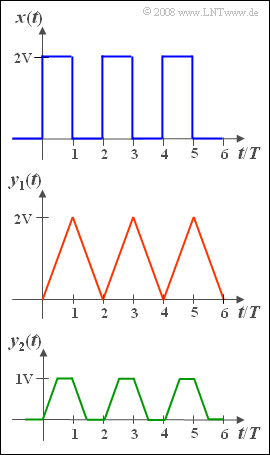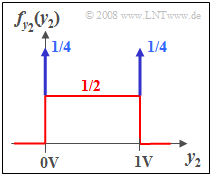Exercise 3.5: Triangular and Trapezoidal Signal
We start from the rectangular signal $x(t)$ according to the upper graph.
- The amplitude values are $0\hspace{0.05cm} \rm V$ and $2\hspace{0.05cm} \rm V$.
- Let the duration of a rectangle and the distance between two successive rectangular pulses be equal to each $T$.
- The random variable $x$ – the instantaneous value of the rectangular signal $x(t)$ – thus has the characteristic values (mean, standard deviation):
- $$m_x = \sigma_x = 1\hspace{0.05cm} \rm V.$$
If we now apply this signal to a linear filter with the impulse response
- $$h_{\rm 1}(t)=\left \{ \begin{array}{*{4}{c}} 1/T & {\; \rm for}\hspace{0.2cm}{ 0\le t \le T} \\\ 0 & {\rm else} \end{array} \right. , $$
then the triangular signal $y_1(t) = x(t) \star h_1(t)$ is obtained at its output according to the convolution with
- the minimum values $0\hspace{0.05cm} \rm V$ $($at $t = 0, 2T, 4T, $ ...$)$,
- the maximum values $2\hspace{0.05cm} \rm V$ $($at $t = T, 3T, 5T, $ ...$)$.
Thus, this low-pass filter is an integrator over the time duration $T$.
If, on the other hand, we apply the signal $x(t)$ to the input of a filter with the impulse response
- $$h_{\rm 2}(t)=\left \{ \begin{array}{*{4}{c}} 1/T & {\; \rm for}\hspace{0.2cm}{ 0\le t \le T/2} \\\ 0 & {\rm else} \end{array} \right. , $$
so the trapezoidal signal $y_2(t) = x(t) \star h_2(t)$. This second filter thus acts as an integrator over the time duration $T/2$.
Hints:
- This exercise belongs to the chapter Uniformly distributed random variables.
- For the corresponding frequency responses $H_1(f=0)= 1$ or $H_2(f=0)= 0.5$.
Questions
Solution
(1) Correct are the proposed solutions 1, 3 and 4:
- The random variable $y_1$ is uniformly distributed and thus just like $x$ also a continuous valued random variable.
- The PDF of $y_2$ exhibits discrete proportions at $0\hspace{0.05cm} \rm V$ and $2\hspace{0.05cm} \rm V$ on.
- There are, of course, continuous valued components between these two boundaries.
- In this domain holds $f_{y2}(y_2) = 1/2$.
(2) The linear mean $m_x = 1\hspace{0.05cm} \rm V$ can be read directly from the data sketch, but could also be formally calculated using the equation for the uniform distribution $($between $0\hspace{0.05cm} \rm V$ and $2\hspace{0.05cm} \rm V)$. Another solution is provided by the relation:
- $$m_{y_{\rm 1}}=m_x\cdot H_{\rm 1}( f= 0) = 1\hspace{0.05cm} \rm V \cdot 1 \hspace{0.15cm}\underline{ =\rm 1\hspace{0.05cm} \rm V}.$$
(3) Actually, the averaging should be done over the whole time domain (both sides to infinity).
- However, for reasons of symmetry, the averaging over the time interval $0 \le t \le T$ is sufficient:
- $$P_{y_{\rm 1}}=\rm\frac{1}{\it T}\cdot \int_{\rm 0}^{\it T} \hspace{-0.15cm}\it y_{\rm 1}{\rm (}\it t{\rm {\rm )}}^{\rm 2}\it \hspace{0.05cm}\hspace{0.1cm}{\rm d}t=\rm\frac{1}{\it T}\cdot \int_{\rm 0}^{\it T} \hspace{-0.15cm}(\rm 2V \cdot \it\frac{t}{T}{\rm )}^{\rm 2} \hspace{0.1cm}{\rm d} t = \rm {4}/{3}\, V^2 \hspace{0.15cm}\underline{= \rm 1.333\, V^2}.$$
- Sharp averaging gives the same result. Using the PDF $f_{y1}(y_1) = 1/(2\hspace{0.05cm} \rm V)$ namely:
- $$P_{y_{\rm 1}}= \int_0^{2V} \hspace{-0.3cm}\it y_{\rm 1}^{\rm 2}\cdot f_{\it y_{\rm 1}}{\rm (}\it y_{\rm 1}{\rm )}\it \hspace{0.1cm}{\rm d}y_{\rm 1} =\rm\frac{1}{2V}\cdot \int_0^{2V} \hspace{-0.3cm}\it y_{\rm 1}^{\rm 2}\hspace{0.1cm}{\rm d}y_{\rm 1} =\rm \frac{8\,{\rm V^3}}{3 \cdot 2\,{\rm V}} \hspace{0.15cm}\underline{= \rm 1.333\, V^2}.$$
(4) The variance can be determined using Steiner's theorem:
- $$4/3\hspace{0.05cm} \rm V^2 - 1\hspace{0.05cm} \rm V^2 = 1/3\hspace{0.05cm} \rm V^2.$$
- The root of this is the standard deviation (standard deviation) we are looking for:
- $$\sigma_{y_{\rm 1}}\hspace{0.15cm}\underline{=0.577 \, \rm V}.$$
(5) The probability we are looking for is the integral over the PDF of $0.75\hspace{0.05cm} \rm V$ to $2\hspace{0.05cm} \rm V$, i.e.
- $${\rm Pr}(y_1 > 0.75\hspace{0.05cm} \rm V) \hspace{0.15cm}\underline{ = 62.5\%}.$$
(6) The PDF consists of two Dirac delta functions at $0\hspace{0.05cm} \rm V$ and $1\hspace{0.05cm} \rm V$ $($each with weight $1/4)$ and a constant continuous component of
- $$f_{y2}(y_2= 0.5\hspace{0.05cm} \rm V) \hspace{0.15cm}\underline{=0.5 \cdot\rm 1/V}.$$
- At $y_2 = 0.5 \hspace{0.05cm} \rm V$ there is therefore only the continuous part.
(7) The mean value $m_{y_{\rm 2}}\hspace{0.15cm}\underline{ =\rm 0.5\hspace{0.05cm} \rm V}$ can be read directly from the above PDF sketch or calculated as in subtask (2) as follows:
- $$m_{y_{\rm 2}} = m_x\cdot H_{\rm 2}( f = 0) = 1\hspace{0.05cm} \rm V \cdot 0.5 {\hspace{0.1cm} = \rm 0.5\hspace{0.05cm} \rm V}.$$
(8) With the above PDF, for given power:
- $$P_{y_{\rm 2}}=\int_{-\infty}^{+\infty}\hspace{-0.3cm}y_{\rm 2}^{\rm 2}\cdot f_{\it y_{\rm 2}}{\rm (}\it y_{\rm 2})\hspace{0.1cm}{\rm d}y_{\rm 2}=\rm \frac{1}{2}\cdot\frac{1}{3}\cdot 1\,V^2+\rm \frac{1}{4}\cdot 1\,V^2 = 5/12 \,V^2 \hspace{0.15cm}{ =\rm 0.417\,V^2}.$$
- The first part goes back to the continuous PDF, the second part to the PDF Dirac function at $1\hspace{0.05cm} \rm V$.
- The Dirac function at $0\hspace{0.05cm} \rm V$ does not contribute to the power. It follows for the standard deviation:
- $$\sigma_{y_{\rm 2}} = \sqrt{{\rm 5}/{\rm 12}\rm V^2 -{1}/{4}\rm V^2}= \sqrt{{\rm 1}/{\rm 6}\rm V^2} \hspace{0.15cm}\underline{=0.409\, \rm V}.$$
(9) This probability is also composed of two parts:
- $${\rm Pr}(y_2 > 0.75 {\rm V} ) = {\rm Pr}(0.75 {\rm V} \le y_2 < 1 {\rm V} ) + {\rm Pr}(y_2 = 1 {\rm V} ) = \frac{1}{2} \cdot \frac{1}{4}+ \frac{1}{4} = \frac{3}{8}\hspace{0.15cm}\underline{ = 37.5\%}. $$

